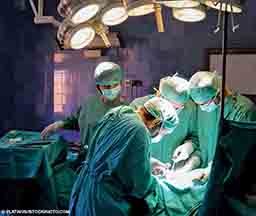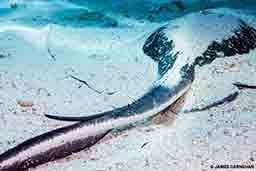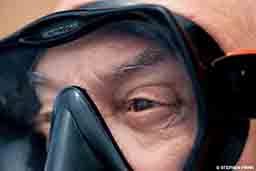Q: I just had lung surgery. When can I safely go back to diving?

A: Lung surgery is done to get a better look at a patient’s lung tissues, often to diagnose, biopsy, repair and/or remove an underlying condition. There are myriad lung conditions that require surgery. Lung cancer, for example, may require surgical removal of the diseased tissue via the chest wall. The surgical approach or technique used will depend on various factors, but it will consist of either an open procedure or video-assisted thoracoscopic surgery (VATS). In an open procedure, the lung is reached through an incision known as a thoracotomy, which allows for direct visualization of the lung. In VATS, the lung is observed using a camera and a series of small incisions, as in laparoscopic procedures (minimally invasive abdominal surgery). Both VATS and thoracotomy allow a surgeon to visually inspect, remove and/or repair tissue. Lung surgery may also be conducted because of severe emphysema, trauma, severe infection of the lungs (tuberculosis, bronchiectasis, etc.), infection of the membranes that line the lungs (empyema), cystic fibrosis, massive bleeding and many other reasons.
Following surgery, divers must be sure the lung has completely healed; a persistent broncho-pleural fistula (communication between the lung and the space surrounding it) could be life-threatening during a dive, particularly during ascent. Lung surgery is subject to a variety of potential complications. The primary concern for divers is the risk of pulmonary overexpansion or pulmonary barotrauma. One postsurgical problem that can increase this risk is the development of adhesions or scar tissue between the surface of the lung and the chest wall. These may cause areas of the lung to be tethered and more susceptible to injury or tearing during the changes in pressure and volume that occur while diving.
After surgery, a person’s lung function (ability to move air in and out of the lungs) changes, and this must be evaluated prior to diving. A diver’s exercise capacity must also be assessed to see if physical performance can be maintained during dives. Other potential problems to consider include the risk of disease recurrence, any effects of radiation or chemotherapy, the type of diving to be done (recreational, technical or professional, for example) and whether the diver could survive with only the operated lung if a dive accident caused a severe injury to the normal lung. These concerns should all be discussed with a pulmonologist and, ideally, a doctor with training in dive medicine.
— Jose Evangelista, M.D.
Q: Last week I did some shore diving in the Caribbean. One of the divers in my group was very diligent about always wading into the water using a technique he called the “stingray shuffle.” Might that technique actually decrease the likelihood of a stingray injury?

A: Shuffling your feet while entering and exiting the water may indeed reduce your risk of being stung by a stingray. Stingray injuries most often occur when the animal is accidentally stepped on or startled. Their flattened bodies facilitate effective concealment beneath the sand, making them difficult to see. Even stepping over a stingray may be perceived as a potential threat and prompt defensive action. Stingrays are not aggressive animals, but their barbed tails are effective defense mechanisms capable of causing lacerations or punctures of the foot or lower leg. Shuffling makes stepping on or startling a ray less likely, and it increases the chances that rays will swim away to avoid contact.
— Niles Clarke, EMT, DMT; Nick Bird, M.D., MMM
Q: A friend and I were discussing how gas supplies are consumed more quickly at deeper depths, and he suggested that “consumption doubles every 33 feet.” That didn’t seem right to me. Could you clarify?
A: This is a common misconception regarding pressure-volume relations and Boyle’s law. The doubling of pressure only occurs between sea level (one atmosphere) and 33 feet of seawater (two atmospheres). The change from 33 feet of seawater to 66 feet of seawater (two to three atmospheres) represents an increase of only 50 percent; the change from 66 feet to 99 feet (three to four atmospheres) represents a 33 percent increase, and the change from 99 feet to 132 feet (four to five atmospheres) represents a 25 percent increase.
Effectively, the compression of gas at 132 feet would account for an approximate five-fold increase in open-circuit air consumption — still critical for planning purposes but nowhere near the 16-fold increase your friend described. It is important to remember that the effect of Boyle’s law represents an arithmetic, not a geometric, progression.
— Neal W. Pollock, Ph.D.
Q: Six weeks ago I had surgery for a detached retina. Will I still be able to dive?
A: The retina is made up of several layers of highly organized light-sensitive cells that line the interior surface at the back of the eye. Its ability to gather light and transmit visual signals to the brain is integral to vision. Retinal detachment compromises this critical function and may result in impaired vision or blindness. Detachments are typically painless, and many are associated with warning signs such as flashes or visual spots.

Retinal detachment is a separation of the layers of the retina from the underlying cells and structures. The most common type of retinal detachment occurs when the vitreous body in the middle of the eye exerts traction on the retina and creates a break that allows fluid to accumulate between the retina and the retinal pigment epithelium.
Various procedures are used to repair retinal detachments. One of these, pneumatic retinopexy, involves the injection of gas into the eye. Individuals who have had a gas bubble placed in their eye should get confirmation from their ophthalmologist that the gas bubble is gone before diving, flying or ascending into mountain regions. An intraocular gas bubble can cause severe eye pain and permanent loss of vision if the individual is exposed to significant changes in ambient pressure.
Some other surgical procedures involve removal of the vitreous fluid and replacement with silicon oil, which remains in the eye until it is removed at a later date. Diving may not be advisable following this type of procedure because it is normally used in the repair of very complicated retinal detachments, and a second surgery may be necessary. Such cases require close communication with your ophthalmologist.
Regardless of the type of procedure, adequate healing time is needed prior to a return to diving. Ophthalmologists recommend waiting two months after retinal detachment surgery before diving, even if all gas is gone before then. Once a gas bubble is gone and healing is complete, there is no reason that diving would constitute a risk to the retina or visual acuity.
— Lana Sorrell, EMT, DMT; Nick Bird, M.D., MMM (with special thanks to Frank Butler, M.D.)
Q: I understand that strenuous exercise after diving is generally not recommended. What, exactly, does “strenuous exercise” mean?
A: Defining “strenuous exercise” simply is difficult. Describing a fixed (or absolute) intensity threshold is not feasible since the impact of any absolute effort will vary between individuals, primarily as a function of body size, body composition, physical fitness and economy of effort (that is, some individuals can do the same task with much less effort than others). Describing a relative intensity threshold indexes the strain to the fitness level of the individual but this, too, is imperfect, since the potentially large differences in absolute work between the very unfit and the very fit can play a role.

The challenge of definition means we have to stick to generalities. Exercise that employs high joint forces such as running or heavy gear lifting should be avoided or delayed following dives. If obligatory exercise such as stair climbing in full gear is required, the hazard can be lowered up front by reducing the stress of the dive. This can be done by reducing the dive depth, minimizing exercise during the descent and bottom phases, maintaining light exercise (two or three times resting effort) during the ascent and stop phases and/or prolonging stop times. The impact of postdive exercise can be reduced by delaying the climb out, making it a slow climb out or taking multiple (slow and easy) trips to recover gear.
Safety may also be increased by maintaining a high level of physical fitness. Optimal body composition could reduce the amount of lead that had to be carried to achieve neutral buoyancy and, in the case of the obligatory postdive climb out, make the effort a relatively small fraction of work capacity to reduce the effective strain.
Ultimately, the best way to reduce decompression stress on any dive is to manage all the contributing factors to push the final balance well onto the side of safety. This may not initially be as attractive as a simple answer, but the challenge of learning and managing the host of potential risk factors can make diving both mentally and physically stimulating.
— Neal W. Pollock, Ph.D.
© Alert Diver — Q1 Winter 2013